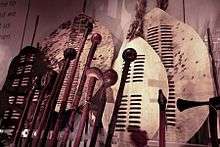Knobkierie

A Knobkierie, also spelled knobkerrie, knopkierie (Afrikaans) or knobkerry, is a form of club used mainly in Southern and Eastern Africa. Typically they have a large knob at one end and can be used for throwing at animals in hunting or for clubbing an enemy's head.[1] The knobkierie is carved from a branch thick enough for the knob, with the rest being whittled down to create the shaft.
The name derives from the Afrikaans word knop, meaning knob or ball and the Nama (one of the Khoekhoe languages) word kierie, meaning walking stick. The name has been extended to similar weapons used by the natives of Australia, the Pacific islands and other places.
Knobkieries were an indispensable weapon of war, particularly among southern Nguni tribes such as the Zulu (as the iwisa) and the Xhosa. Knobkieries were occasionally used during World War I.[2][3] The weapon was carried by British soldiers in Siegfried Sassoon's fictionalised autobiography.[4]
During the Apartheid era in South Africa, they were often carried and used by protesters and sometimes by the police opposing them.[5][6]
Knobkieries are still widely carried, especially in rural areas, while in times of peace it serves as a walking-stick, sometimes ornamental. Knobkieries that serve this function are on the current South African Coat of Arms[7] and on the Order of Mendi for Bravery.[8] A knobkierie appeared on the flag of Lesotho 1987-2006, on the Coat of Arms of Lesotho since its independence in 1966, and on the Coat of Arms of the Republic of Ciskei.
Uses for Sotho People
Known as molamu, it is a stick or kierie in Afrikaans, it can be a walking stick or alternatively, it can be used as a weapon[9]. The molamu is a stick that is made from the Mohlware tree Olea africana[10]. It is a fighting stick carried by men and boys from puberty.
Practical Use
A molamu symbolises authority and power, and represents a readiness to separate an enemy from a friend. The molamu is to symbolically used to break, to protect, to judge and to rectify social injustices.
Initiation
The molamu is an indicator of one's adult male status along with the Basotho blanket seana marena, and are visual expressions of both practical and esoteric Sesotho ideals[11]. Molamu is a sign of manhood, all male initiates carry it upon their return from lebollo la banna. The molamu is traditionally passed down from one generation to another as men go through initiation. It is used to declare to Badimo that the young man has returned from his initiation, and garners their support and blessings[12]. The molamu is held up while the initiates sing “ditoko”, with the singer's eyes intently focused upon it. The molamu is also used to teach initiates the methods of “ho ya ka lanwa”, which is a historical Sesotho martial art[13].
Spiritual Use
The molamu is also used to bind empowering medicines, or moriana, to the staff, which affects the “seriti” which is the character or spirit of the owner. It is also a visual indicator of one's transition to adulthood, and maintains spiritual significance in Sesotho society[14].
Modern uses
Following an initiate's public introduction as a functioning member of Sesotho adult society the molamu is typically stored in the ceiling of one's home, and represents the physical presence of the unseen.
In contemporary southern Africa, one can also find decorative variations carried by new initiates after returning to their homes. These serve as accessories to the heavily ornamented outfits worn by the young men as a sign of celebration during the weeks following their return, and equally express the celebration of newly gained adulthood, drawing attention to the initiates[15].
See also
- Rungu (weapon)—a similar club common in East Africa
- Shillelagh
- Wilbur Smith, the South African author, in his book When the Lion Feeds, also refers to these weapons as kerrie which are used to throw at birds and animals in the bush to kill them.
- Sotho people
References
- ↑ Rudolph, C. J. A guide for the Zulu court interpreter. Pietermaritzberg: Shuter & Shooter.
- ↑ Canada in the Great World War: an authentic account of the military history of Canada from the earliest days to the close of the war of the nations. Toronto: United Publishers of Canada. 1918.
- ↑ Dawson, Alec John (1918). A "Temporary gentleman" in France; home letters from an officer at the front. London, New York: Putnam. p. 94.
- ↑ Sassoon, Siegfried (1930). Memoirs of an Infantry Officer. Faber & Faber. ISBN 978-0571268443.
- ↑ "Amnesty Hearing - Vlisi Thokozani Manqele". Department of Justice and Constitutional Development. 1999-02-01. Retrieved 2008-11-27.
- ↑ "Amnesty Hearing - Victor Mthandeni Mthembu". Department of Justice and Constitutional Development. 1998-07-06. Retrieved 2008-11-27.
- ↑ "National Coat of Arms". South African Government Information. Retrieved 2008-11-27.
- ↑ "National Orders". The Presidency of the Republic of South Africa. Archived from the original on September 15, 2008. Retrieved 2008-11-27.
- ↑ https://africa.uima.uiowa.edu/topic-essays/show/43?start=0
- ↑ Nakin, Moroesi R; Kock, Inie J (2016). "Insights into translation and the original text: Thomas Mofolo's Chaka". Tydskrif Vir Letterkunde. 53 (2). doi:10.17159/tvl.v.53i2.9.
- ↑ https://africa.uima.uiowa.edu/topic-essays/show/43?start=0
- ↑ Riep, David Matthew Merkel. "House of the Crocodile: south Sotho art and history in southern Africa." PhD (Doctor of Philosophy) thesis, University of Iowa, 2011.http://ir.uiowa.edu/etd/2616. Futhwa, Fezekile. "Setho: Afrikan Thought and Belief System. Nalane ka Fezekile Futhwa, May 2011
- ↑ https://africa.uima.uiowa.edu/topic-essays/show/43?start=0
- ↑ https://africa.uima.uiowa.edu/topic-essays/show/43?start=0
- ↑ Riep, David Matthew Merkel. "House of the Crocodile: south Sotho art and history in southern Africa." PhD (Doctor of Philosophy) thesis, University of Iowa, 2011.http://ir.uiowa.edu/etd/2616. Futhwa, Fezekile. "Setho: Afrikan Thought and Belief System. Nalane ka Fezekile Futhwa, May 2011
Further reading
- Dougherty, Terri (2008). Zulu Warriors. New York: Capstone Press.
- Journal of Natal and Zulu History (1992). University of Natal. Dept. of History. Durban: South Africa.
- Knight, Ian (1989). The Zulus. London: Osprey Press.
External links
